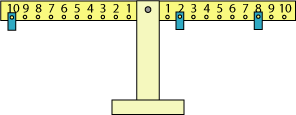Copyright © University of Cambridge. All rights reserved.
'Mechanics in the Primary Years' printed from https://nrich.maths.org/
Show menu
In years gone by, before the advent of the National Curriculum, the practical activities in the Primary School that are the forerunners of 'Mechanics' were seen as part of the maths syllabus*. At that time, strange as it may seem to today's primary teachers, science was not a central part of the work in school during the primary years. Now, however, these activities are covered in the Science curriculum.
The background to Mechanics is based in Newton's laws. These are about 'forces', 'motion', 'acceleration' and 'equilibrium' (that is having no acceleration). This may seem an unduly complicated aspect for primary pupils and their teachers, and some of it is not covered at this stage, but is in fact part of our every day experiences. To turn these experiences into conscious thoughts, children need to engage in relevant practical activities and be given the language to internalise and discuss them.
The idea of a 'force' can be experienced by pushing and pulling objects, and stretching elastic bands and springs. Force is measured with a forcemeter. Gravity can be seen as a force by rolling marbles or toys with wheels down a slope. 'Friction' can also be explored using a forcemeter by dragging and rolling objects over various surface. Air resistance is demonstrated well by model parachutes.
The idea of 'equilibrium' is rather more difficult in a way. In the sense it is used in primary schools, nothing is happening, everything is stationary*. It can be illustrated when balance scales are used for weighing. However, these are seldom used at KS 2. A 'number balance' (also called 'a balance bar' or 'equaliser') can be a useful piece of equipment that can also be used for explorations in number by younger children. Weights are hung below the numbers:

A number balance or equaliser
The Science curriculum as used by many primary schools can be found in the DfEE Raising Standards Science publication*. This divides each year's science into six units, of which one is relevant to 'mechanics', each requiring from 7 to 9 hours work depending on age.
At KS 1, children find out about Pushes and Pulls
through playing with moving toys such as trolleys, toys that move, water and sand wheels, and discussing and reporting on their discoveries. In Year 2 they experiment with toy cars on ramps, comparing the distance travelled by vehicles of different sizes and weights, and with ramps with varying slopes and surfaces*.
During Years 3 and 4 children will encounter springs and elastic bands used for propulsion. They will use forcemeters to measure weight and friction over different surfaces, and use model parachutes or paper cake cases to demonstrate air resistance. They will be encouraged not only to discuss these concepts but also make predictions*.

A forcemeter
By the top end of the primary school children will have met more facts and will also have developed many that they had encountered earlier. The unit in Year 5 is mostly devoted to information about gravity and the solar system. In Year 6 they will use forcemeters to weigh objects in air and water, including those that float. They will make graphs about such things as stretching elastic bands with different weights, and looked at the results of weighting paper parachutes and spinners with paperclips*.
Through all this the importance of discussion and prediction are emphasised. These are very important in learning, but so also are practical activities. This is immortalised in the Chinese proverb introduced to maths in the mid 1960s*:
"I hear and I forget, I see and I remember, I do and I understand."